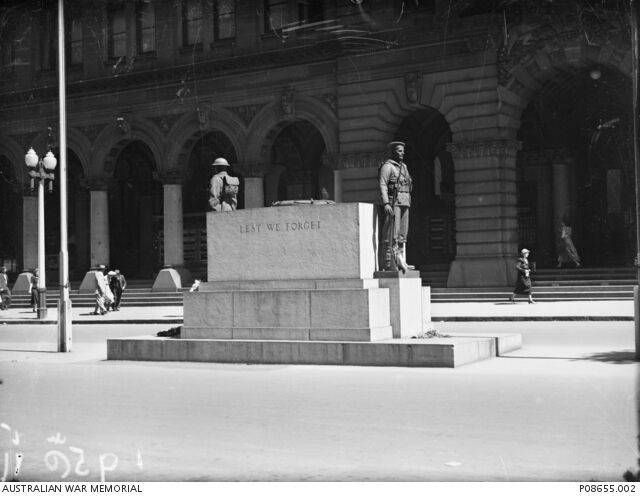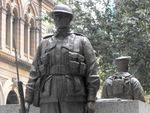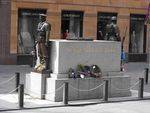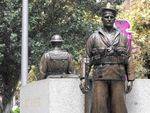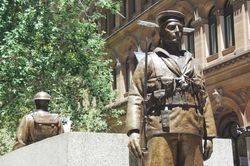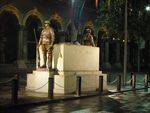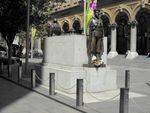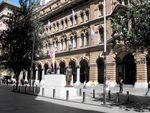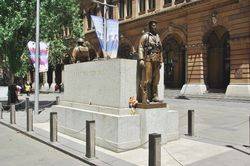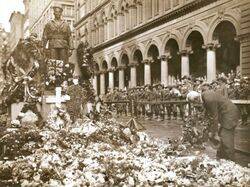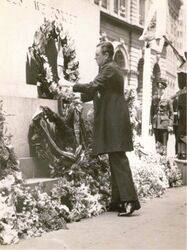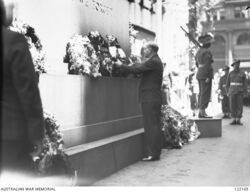
Sydney CenotaphPrint Page 
The Sydney Cenotaph was originally erected to commemorate those who died in service or were killed in action in World War One. The Cenotaph is now used to commemorate all wars and conflicts. The statues at the cenotaph were unveiled on the 21st February 1929.
The cenotaph has been declared a “Military Memorial of National Significance” under the Military Memorials of National Significance Act 2008.
Martin Place was recommended by the Returned Sailors and Imperial League of New South Wales for the erection of the Cenotaph, as many returned veterans associated the location with recruiting programs and patriotic rallies conducted throughout the First World War. The Cenotaph`s base is comprised of 23 pieces of Moruya granite, the same stone as used for the Sydney Harbour Bridge pylon facings. Sydney City Council Archives documents record that Leading Signalman John William Varcoe RAN was the naval model with Private William Pigot Darby representing the Australian Imperial Force (A.I.F.) soldier.
SYDNEY, Monday. The dedication ceremony of the permanent Cenotaph, comprising a massive Granite stone of remembrance set on a base of polished granite which has been erected in Martin place, Sydney, was performed in the presence of 20,000 people at I o'clock to-day. The Premier (Mr. Lang) delivered the dedicatory speech, and the Governor (Sir Dudley de Chair) laid the first wreath. The Consuls of the allied nations, wearing full dress uniform, clustered about this first tribute their own immense wreaths, and within a short period of the undraping at the Cenotaph the huge altar of stone was hidden under a mountain of flowers. The simple ceremony was begun with the singing of the National Anthem, after which the Governor congratulated the Returned, Sailors and Soldiers' League on the splendid monument that had been achieved, mainly through its effort. "One cannot say with what eyes posterity will regard this Cenotaph," continued, the Governor, "or what ideas it will arouse in their minds. One can only hope and pray that as a result of what our gallant men have done and suffered they may be able to look back upon war, its instruments, and its organization, as belonging to a dead past." Lieut.-Gen. Sir Harry Chauvel explained the importance to the British Empire of the date (August 8), which had been selected for the dedication. That day, he said, marked the beginning of the British share of the great counter-offensive in France and Flanders, which did not cease until Germany sued for peace in November of the same year.
The Premier, in dedicating the memorial, said that the tribute to the dead they all desired could be achieved by the raising of such monuments, which would ensure that the memory of their heroic deeds and noble sacrifice would remain for ever with the people. One of those monuments could be built so easily — it was the monument of stone, similar to that they would dedicate that day. The other form was just as permanent, but much more difficult to build. It was a task that would require all their energy, patience, and ability; but if they could complete it they would have done the greatest thing they could. The monument of which he spoke was the ordering of conditions so that the scourge of war would be eliminated. The men whose deeds they honoured believed that their country was in danger, and they gave their lives to keep her free. Nothing the future historian might discover could embellish their noble deed, nothing that might be found could diminish the glory of their sacrifice.
As the Premier's words died away two Victoria Cross winners hoisted the flags which had covered the Cenotaph. The Governor then placed on the memorial the first wreath on behalf of the people of New South Wales. He was followed by the Minister for Home and Territories (Mr. Marr), who, as representative of the Federal Ministry, placed the second wreath. Wreaths were then placed by the Consuls of America, Belgium, France, Italy, Japan. Rumania, and Jugo-Slavia. The Lord Mayor (Ald. Mostyn), on be half of the city council, accepted the care of the memorial.
Register (Adelaide), 9 August 1927.
Though the business and traffic of the city went on as usual Martin Place, from the Commonwealth Bank to George Street, was densely crowded for the unveiling of the statues of a soldier and sailor, by Sir Bertram Mackennal, at the cenotaph, which was performed by the Premier, (Mr. T. R. Bavin) yesterday. A square of bright colour surrounded the cenotaph. Khaki uniforms and the ribbons and medals and the regimental colours of the A.I.F. units made a brave display. Troops, headed by bands, buglers, and trumpeters, marched from the Domain via Macquarle, Hunter and George Streets, and were early in position. Punctually arrived the Governor (Sir Dudley de Chair), the Premier (Mr. Bavin), the Civic Commissioners, and Sir John Monash. The Post Office clock, striking one, broke the prayer offered by Dean Talbot. This was followed by the National Anthem. Then led by the bands, the people joined in singing "O God, Our Help In Ages Past." Mr. Bavin said that it was fitting that whatever was to be said should be spoken by Sir John Monash, who had played a great part in the events which they were commemorating. The statues completed a memorial, which was an expression of admiration of the people of the State for the brave deeds of our soldiers and sailors. Mr Bavin pulled the purple cord, which released the flags draped around the structures, while buglers sounded the "Last Post." The flags on the tail poles at each end of the cenotaph remained at half mast, but when the last note of "Reveille," sounded by the trumpeters died away the flags were hoisted, to the peak.
Telegraph (Brisbane), 22 February 1929.
Location
| Address: | Martin Place, Between George & Pitt Streets, Sydney, 2000 |
|---|---|
| State: | NSW |
| Area: | AUS |
| GPS Coordinates: | Lat: -33.86752 Long: 151.20778 Note: GPS Coordinates are approximate. |
Details
| Monument Type: | Monument |
|---|---|
| Monument Theme: | Conflict |
| Sub-Theme: | Multiple |
| Designer: | Sir Edgar Bertram Mackennal |
| Monument Manufacturer: | Dr. John Bradfield & Dorman Long Company |
| Link: | http://www.warmemorialsregister.nsw… |
Dedication
| Actual Monument Dedication Date: | Monday 8th August, 1927 |
|---|
Lest We Forget
To our glorious dead


